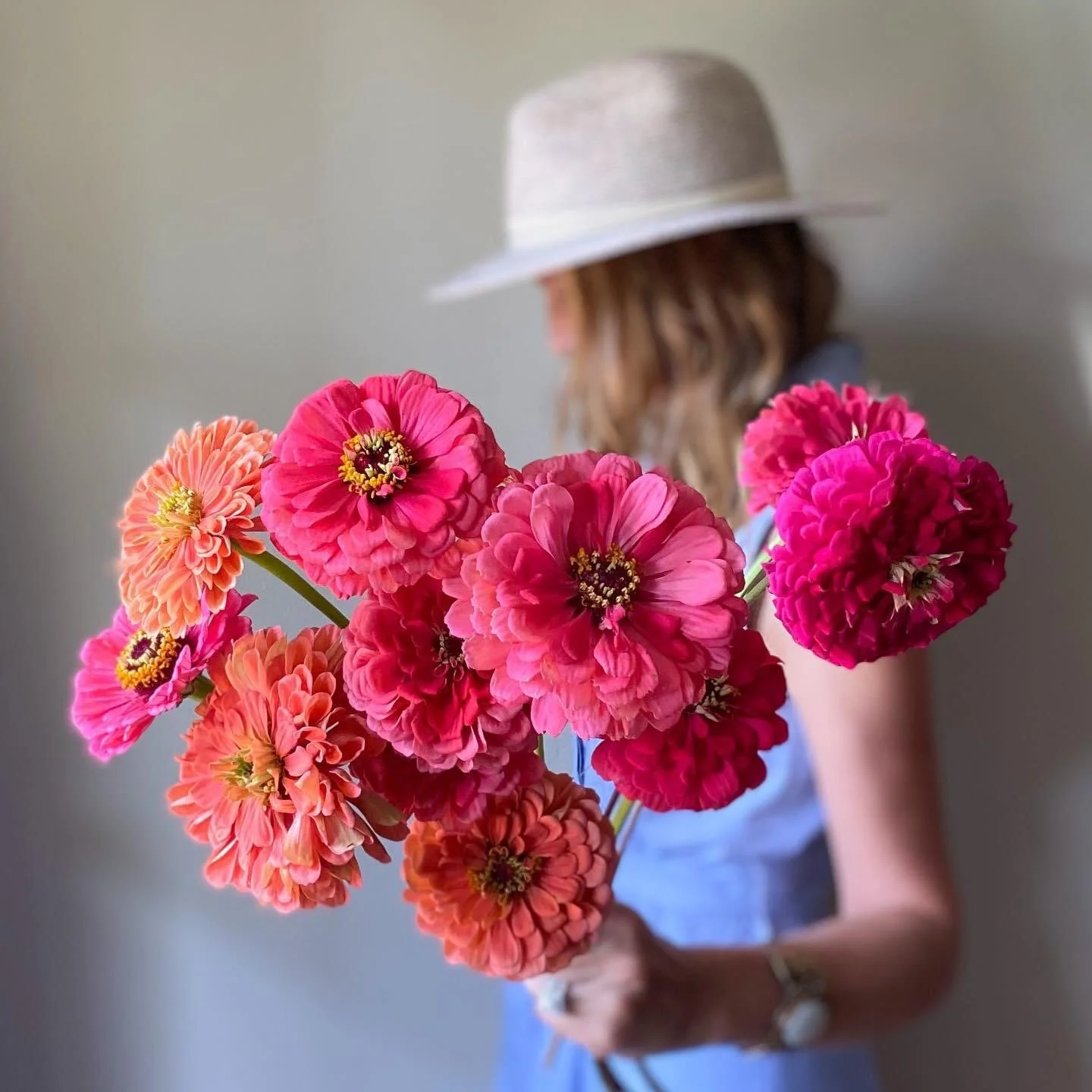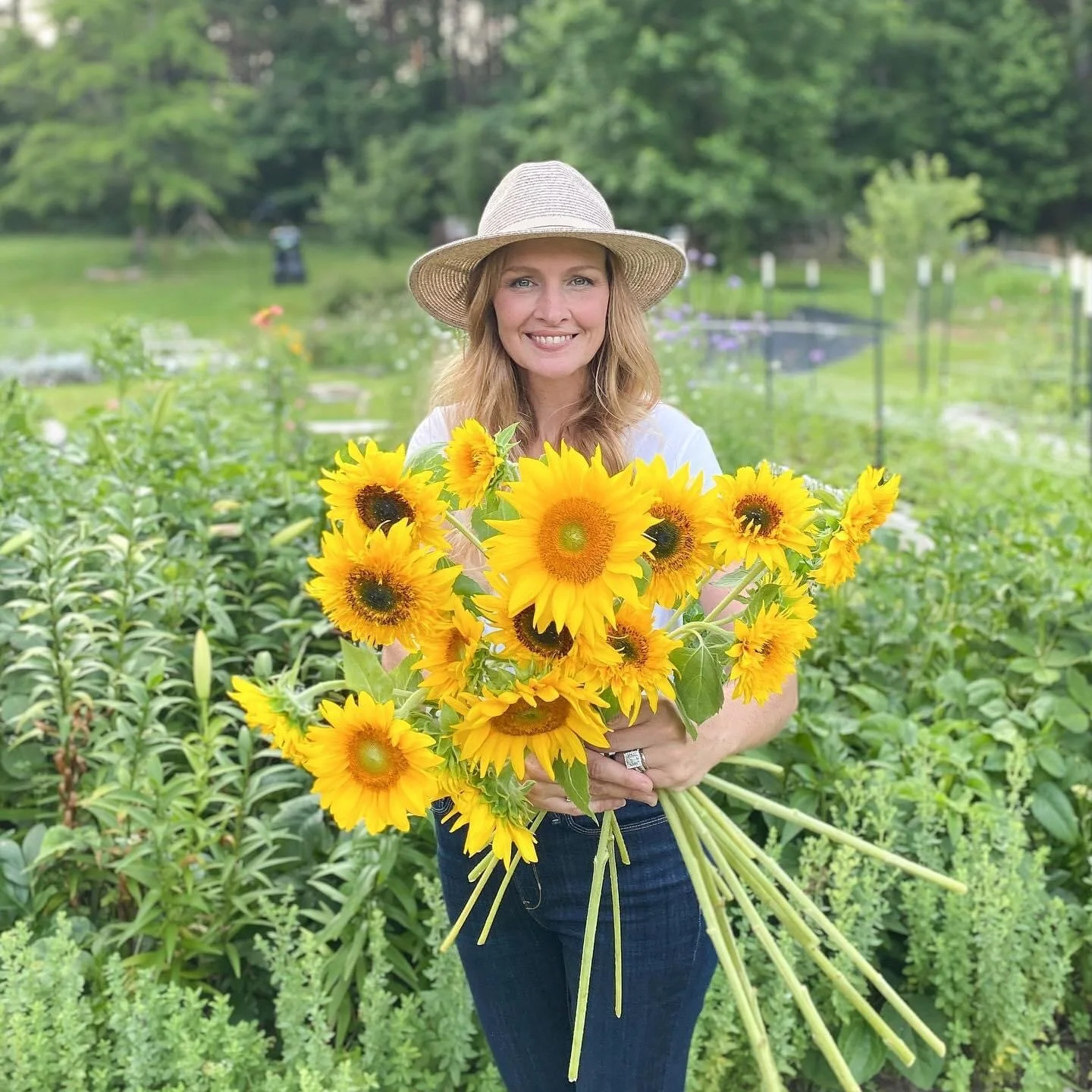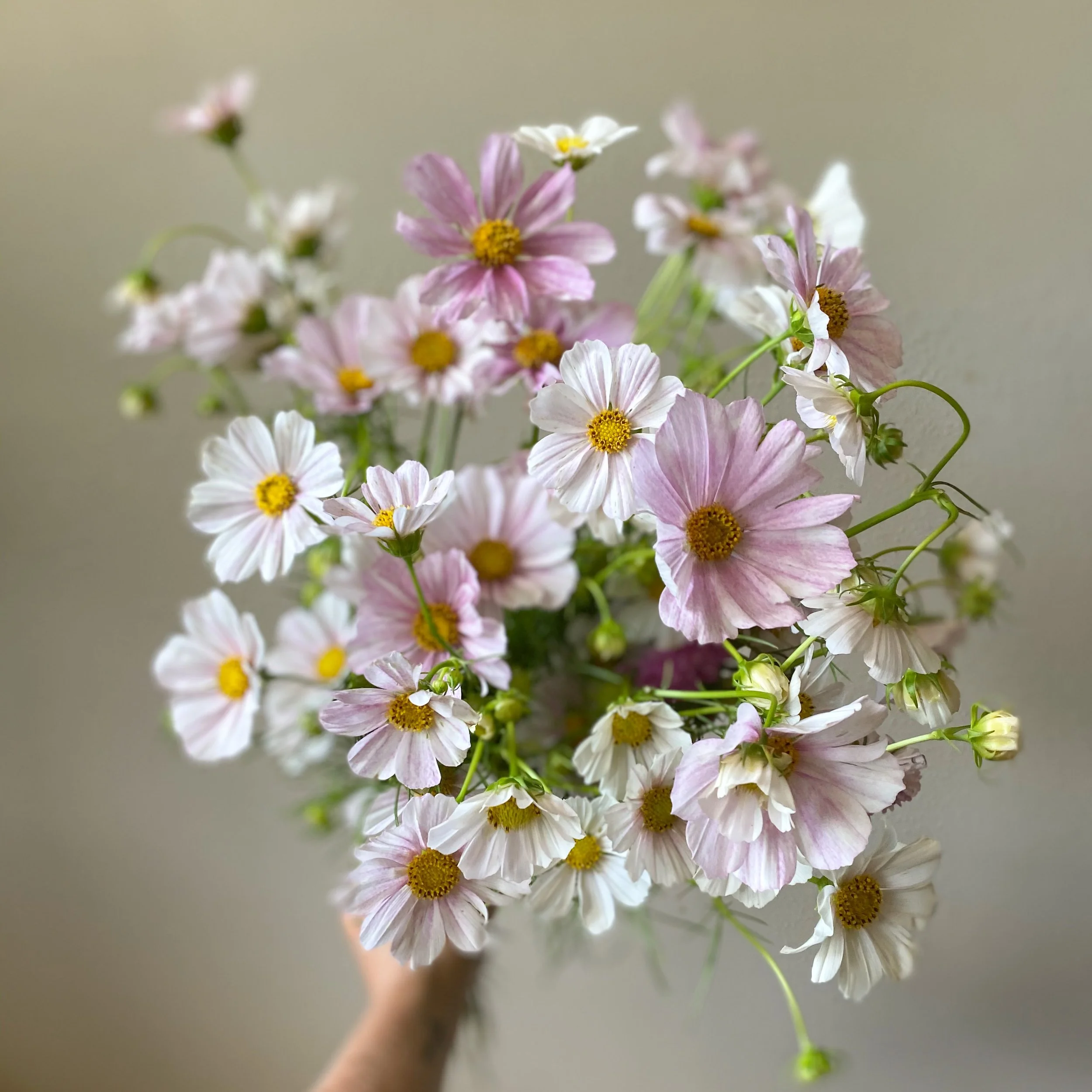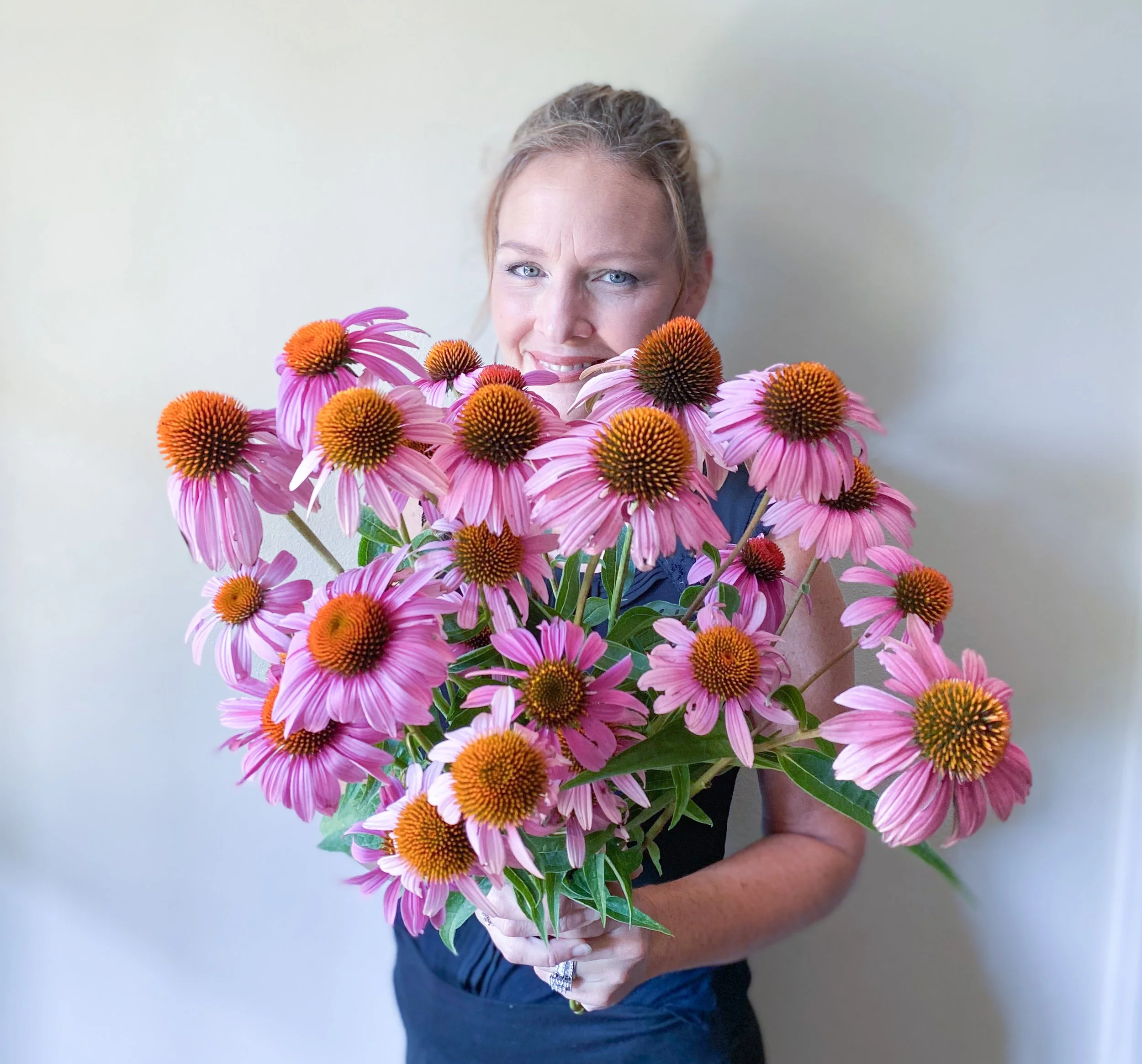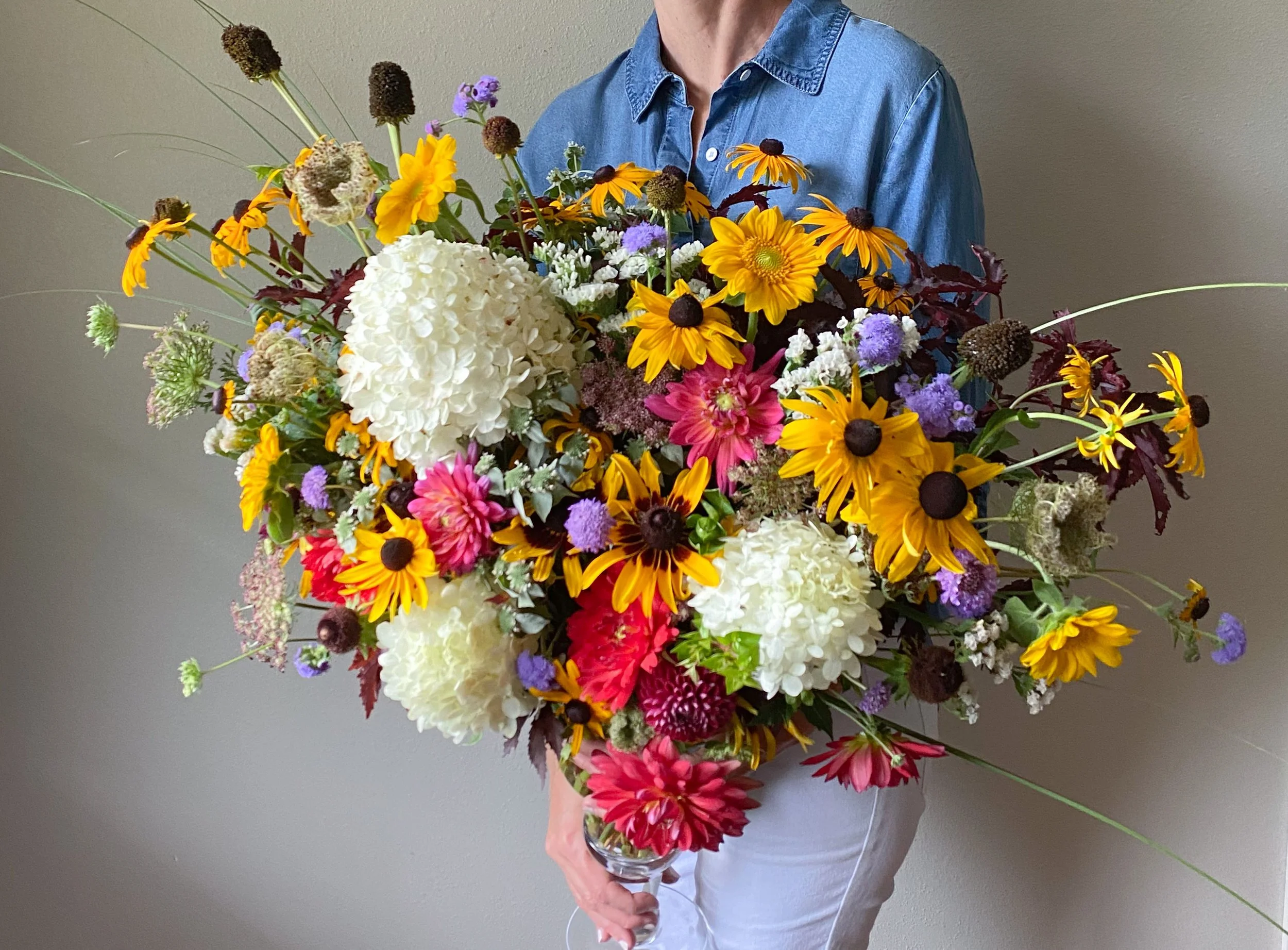5 Favorite Plant Varieties for the Home Gardener
Mixed florals - Sunflowers, zinnias, campanula, rudbeckia, lisianthus
Would you like to plant a cutting garden, but not sure where to begin?
A few years ago, I felt the same way!
I wanted to grow enough flowers to design pretty arrangements, but I didn’t know what I should be growing to have a wide variety of flowers with different shapes to make an interesting design.
I grew a lot of zinnias. So I had bouquets full of zinnias. They were pretty, but kind of plain and boring.
Don’t get me wrong. Zinnias are beautiful, fun, and cheerful. But they’re even better when they’re blended with other flowers.
I did some reading and research, and learned about other flowers that I wanted to grow. So now I’m passing on some of that information to you, so that you can learn about some easy to grow plants that produce beautiful blooms to use as cut flowers.
I’m keeping this list down to what I consider to be the easiest plants to grow for cut flowers. If you’re new to gardening, you can use this short list to get some great experience with easy growing plants and then branch out to other varieties that are a little more challenging to grow.
Zinnias
Benary’s Giant zinnias - ‘Salmon Rose’ and ‘Carmine Rose’
Let’s Start With Zinnias
Zinnias are beautiful! Zinnias are fun! Zinnias are cheerful! AND GUESS WHAT? Zinnias are super easy to grow!
We grow mostly Benary’s Giant zinnias. They have big, beautiful blooms and come in a wide range of colors. They produce loads of blooms for 2 - 3 months, then start slowing down.
You can find professional quality seeds here. The seeds we offer were chosen for their beauty, vigor, stem length, vase life, and growth in our climate. Over the years, we’ve trialed hundreds of cut flower varieties on our Mississippi farm to discover what grows best here in the South, zone 7b.
Zinnias are one of the easiest plants to start from seed. You can start them indoors 4 - 6 weeks before your last anticipated frost, or just wait until the ground is warm enough to plant outside. For us, that’s around mid April.
I start some seeds early and keep them under grow lights until time to plant outdoors, but the majority of our seeds are planted directly into the soil throughout the growing season.
Keep them watered well, keep them cut as they bloom, and they’ll give you loads of beautiful blooms for 2 - 3 months. Then they start slowing down. We succession plant zinnias every 3 weeks so that we have zinnias blooming from early summer until first frost in the fall.
Sunflowers
‘Starburst Panache’ and ‘Pro Cut Gold’ Sunflowers
Sunflowers are another easy to grow cut flower.
There are so many different varieties to choose from, but keep in mind that when you see a field of sunflowers blooming, those are not cut flower varieties. Those sunflowers are grown for pollinators to enjoy and they produce a lot of pollen. Cut flower varieties are bred to be pollenless and are meant to be cut before they’re pollinated. We try to cut our sunflowers as they are just beginning to unfurl for the best vase life.
There are single stem varieties of sunflowers and branching varieties. The single stem varieties produce one bloom per seed planted. When that stem is cut, the plant is done producing. Branching varieties have the ability to produce several blooms per seed planted. You can get 6 - 10 stems of cut flowers from a branching variety if you pinch early in it’s growth.
We grow mostly single stem varieties. We plant a LOT of single stem sunflower seeds weekly during the growing season. We also grow a couple of varieties of branching sunflowers.
For the home gardener, I recommend branching sunflowers. If grown correctly, you get 6 - 10 stems of sunflowers that are the perfect length to use as cut flowers. Two branching varieties that I love are ‘Starburst Panache’ and ‘Ruby Eclipse’.
Branching sunflowers require pinching early on as they’re growing to be able to produce several usable stems. Pinch when 8” - 12” tall. To do this, you simply locate the tiny central bud and pinch it off with your thumbnail. This will encourage other stems to grow longer and give you stems the right length for a vase.
In the above picture, I am holding the branching variety ‘Starburst Panache” and the single stem variety “Pro Cut Gold”. You can purchase these professional quality seeds directly from us here!
Cosmos
‘Versailles Flush’ Cosmos
Cosmos lends an airy and delicate quality to designs. They’re also very easy to grow.
They don’t require rich soil, and actually grow better in soil that hasn’t been enriched with compost or fertilizer, which makes them perfect if you grow in heavy clay soil like we ours.
All you really need to be successful with cosmos is warm soil, water, and support.
To plant, loosen the soil and cover the seeds. Keep them watered as they’re growing and be prepared to give them support because they can get quite tall.
Cosmos serves a dual purpose for us. I grow them mainly for their beautiful blooms, but I also like to use the foliage in design work. The foliage is fern-like and blends perfectly with other summer blooms.
There are so many beautiful varieties of cosmos to choose from. My favorite variety is ‘Versailles Flush’, pictured above. It blends with everything and is perfect for wedding design work.
Echinacea
Echinacea ‘Magnus’
Echinacea, commonly known as Purple Coneflower, is a perennial that pollinators love. It makes a great cut flower if harvested early, before too many pollinators get to it. It’s also a great plant to have in the landscape if you’re an observer of wildlife. (great for butterfly gardens!)
Echinacea is easy to grow and not picky about the soil. One of the reasons I started growing echinacea was because of it’s tolerance for clay soil!
Echinacea can be started from seed, but it takes time for it to get big enough to start blooming when started from seed. Echinacea plants are easily found at most garden centers in early summer.
After the petals lose their luster, the central cones are still very useful in late summer and fall design work. Just pick off the petals and use the cones in your arrangement with sunflowers and rudbeckia for a beautiful display.
Being a perennial, echinacea will come back each year, and can be divided as it grows to give you additional plants.
If you enjoy birdwatching, echinacea is a great choice for your garden. We love to see the goldfinches flock to echinacea and rudbeckia cones that we leave for them.
Rudbeckia
Mixed bouquet with several varieties of rudbeckia and rudbeckia cones, limelight hydrangeas, dahlias, scabiosa, laceflower, and grasses
Rudbeckia is a late summer favorite! There are perennial varieties and annual varieties. We grow both.
Rudbeckia is an easy to grow plant that tolerates both clay soil and drought conditions, which makes it perfect for our climate and our soil.
In late summer, when so many other plants are struggling to survive in the heat and drought, rudbeckia just keeps on giving blooms. We do water our rudbeckia when we’re not getting rain, but not as frequently as the other plants.
Rudbeckia is beautiful as a landscape plant, but equally as beautiful as a cut flower.
Different varieties grow to different heights. We grow some rudbeckia plants that get 7 feet tall (‘Maxima’), and some that stay relatively short, like ‘Sahara’, at 24 inches.
Some of my favorite rudbeckia varieties are the perennials ‘Henry Eilers’, and ‘Triloba’.
If you’re a birdwatcher, you should know that rudbeckia cones are goldfinch magnets. We love watching the goldfinches flit back and forth between the rudbeckia and echinacea as we’re working outside. And a bonus for the wildlife - the cones that are left on the plants will continue to feed the birds well into winter!
Now that you know about these 5 easy plants to grow in your cutting garden, all that’s left is for you to find some seeds, get out there, and get your hands in the soil. Growing and nurturing plants is so rewarding, and having beautiful flowers to cut and bring inside is pure joy!
If you enjoyed these tips, please share with a friend who could also use this information.
Keep on smiling flower friend!

